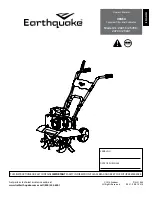
MNL_Standard-NoSpecs_ACWC-18to240-E-_(0713).docx
- 15 -
VII.
TROUBLESHOOTING (BASIC GUIDE)
•
The Troubleshooting Guide below is to be used as a guide only. All work should be performed by a trained
technician and only with proper understanding of the system. Contact manufacturer for further assistance.
•
Prior to resetting any safety devices, ensure that the issue is resolved or use care in operating the system until
the cause is determined.
SYMPTOM AND PROBABLE CAUSE
PROBABLE REMEDY
COMPRESSOR DOES NOT RUN
1.
Power line open.
1.
Reset circuit breaker/disconnect.
2.
Contactor stuck open.
2.
Replace contactor.
3.
Loose terminal connection.
3.
Check connections. Tighten.
4.
Improperly wired controls.
4.
Check and rewire.
5.
Seized compressor.
5.
Check motor winding for open or short. Replace
compressor, if necessary. Determine cause.
6.
Low line voltage.
6.
Check line voltage — determine location of voltage
drop and remedy deficiency.
7.
Compressor motor defective.
7.
Check motor winding for open or short. Replace
compressor, if necessary.
8.
Flow Safety Tripped
8.
Determine cause of low flow issue and resolve.
-
Check reason for no flow. If flow is present,
verify amount (~3 gpm/ton).
-
Verify flow is sufficient to the evaporator
during all process circuit operations.
-
Adjust fluid bypass valve to increase flow.
-
Do not reset unless issue has been resolved.
-
Troubleshoot the switch. DO NOT BYPASS!
IMPORTANT! This condition can occur when
the fluid in the evaporator nears freezing.
9.
Flow Switch Tripped (switch open)
9.
Determine cause of low flow issue and resolve.
(See Flow Safety Tripped)
10.
Freeze Safety Tripped
10.
Determine cause of low flow issue and resolve.
(1)
(See Flow Safety Tripped)- Typically,
this is an automatic reset.
COMPRESSOR STOPS ON LOW-PRESSURE SWITCH
1.
Compressor suction shutoff valve partially closed.
1.
Open valve.
2.
Low refrigerant charge.
2.
Determine cause of low refrigerant. Add
refrigerant.
3.
Liquid line solenoid valve(s) fails to open.
3.
Check liquid line solenoid valve for proper
operation. Replace if necessary.
4.
Liquid line shutoff valve closed.
4.
Open valve.
COMPRESSOR STOPS ON HIGH-PRESSURE SWITCH
1.
Compressor discharge valve partially closed.
1.
Open valve or replace if defective.
2.
Air in refrigerant system.
2.
Purge and evacuate system, as appropriate.
3.
Condenser fan(s) not operating.
3.
Check, then repair or replace if defective:
a. Motor/motor wiring.
b. Head pressure switch.
c. Capacitors.
4.
System is overcharged.
4.
Reclaim charge as needed.
5.
Condenser coils dirty.
5.
Clean coils, properly.
6.
Ambient temperature too high for charge.
6.
Reclaim charge as needed.
7.
Partially plugged expansion valve or filter drier.
7.
Clean or replace.
8.
Condenser coils dirty.
8.
Clean coils, properly.














































